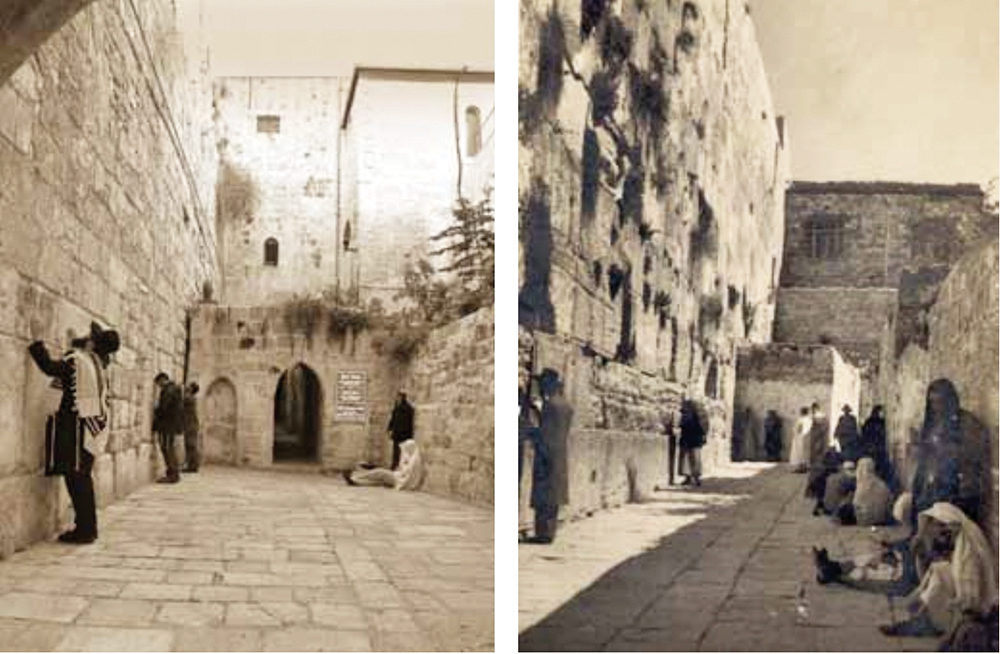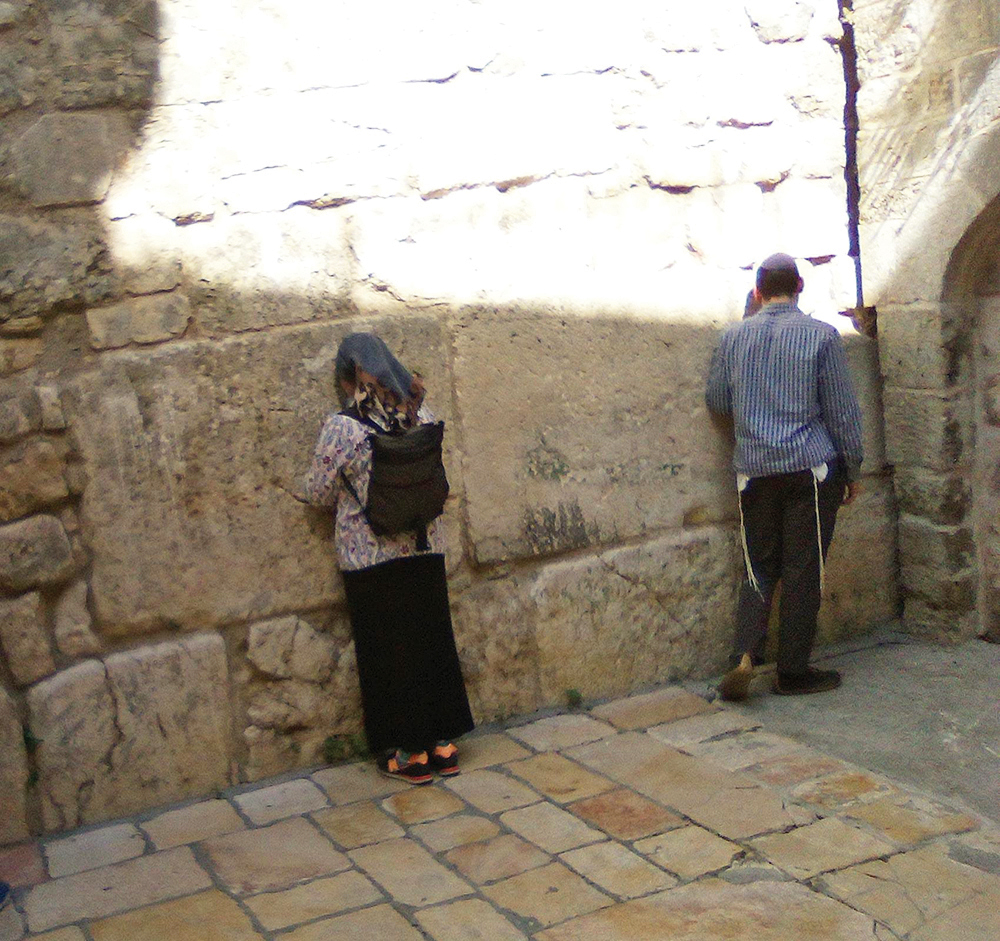
You may be wondering, what is the Kotel HaKatan? Does it have anything to do with the Kotel HaMaaravi (the Western Wall)? And, if so, why have I never heard of it?
When the “Kotel” is spoken about in conversation, it often refers to the 187-foot prayer space that is flanked by the Kotel Plaza. However, the “Kotel,” or western wall of Har HaBayit, actually spans 1,600 feet in its entirety.
So, where are the other 1,413 feet?
Anyone who has been on the Kotel tunnel tours knows that despite its already towering height, the Kotel at which we pray actually descends another 43 feet below ground. The same is true regarding its length: despite its prayer space measuring 187 feet, the Western Wall extends another 265 feet to its south in an area that includes the Kotel’s egalitarian section and an archeological site where Har HaBayit’s western wall connects to its southern wall to form its southwest corner. That brings us to 452 feet. The remaining 1,148 feet is found to the north, mainly in the Muslim Quarter (“The Disappeared Wall,” Nadav Shragai, pp. 24-25 [Hebrew]).
However, even in the Muslim Quarter, the majority of the Har HaBayit wall remains hidden from view. That section of the Kotel is either covered by Arab houses or may be used as the actual fourth wall of their homes. Imagine that—the Kotel as a home’s fourth wall; that’s true “Jerusalem stone.”
Yet, there is one small section not built upon by Arab homes. It stands 574 feet north of the Kotel Plaza and is easily accessible. It spans only 651/2 feet and doesn’t have a plaza. Rather, it is just 13 feet wide and looks almost identical to how the Kotel HaMaaravi looked before the Kotel Plaza was created in 1967 (Shragai, pp. 20, 24). Because of its miniature size, it was coined the Kotel HaKatan, the “Small Western Wall.”

(Credit: Shlomo Deutsch)
Rosh Hashanah 2006
One of the special tefillot held yearly at the Kotel HaKatan is the morning service of Rosh Hashanah. As thousands pour into the Western Wall plaza every Rosh Hashanah, a small handful of Jews who are “in the know” navigate the alleys of the Muslim Quarter to arrive at the Kotel HaKatan.
But, in 2006, it wasn’t just Jews weaving through the nearby alleyways. That year, the month of Ramadan coincided with Rosh Hashanah. As the minyan approached Tekiat Shofar (shofar blowing) on the second day of the holiday, hundreds of Muslims made their way to the Al-Aqsa Mosque via the Iron Gate (Shaar HaBarzel), a gate to Har HaBayit a short alley away from the Kotel HaKatan.
The shofar blower, Eliyahu Kleiman, a 20-year-old Old City resident and yeshiva student, finished saying the “Malchiot” verses that precede some of the shofar blasts. Just as Jews blew shofar at the large Kotel, Kleiman brought his lips to his shofar and began to sound Tekiah! Shevarim! Teruah!
At that moment, something unexpected happened. An Israeli police officer who had been manning the Iron Gate ran to the Kotel HaKatan and demanded that Kleiman stop blowing and put away the shofar.
Kleiman pointed to his siddur, indicating that he was in the middle of prayer and had no intention of stopping the service. The officer insisted that Kleiman stop and another six officers rushed to the scene to confront the stubborn shofar blower.
Kleiman continued to refuse. He pointed again to his siddur with irritation and hid the shofar deep within his jacket pocket. The head officer grabbed Kleiman to lead him out, but Kleiman had his feet together in the Shemoneh Esrei stance and wouldn’t budge. The officer continued to pull Kleiman until he fell on the stone floor. The other officers assisted in dragging him across the Kotel HaKatan floor until they arrived at the Iron Gate a couple dozen feet away. Curious Muslim worshippers on Har HaBayit peeked through the gate to see the defiant Jew continue his Shemoneh Esrei. The officers relented and permitted him to finish his own personal prayer before walking him to the police station, where he was held for several hours and then freed on condition that he does not approach the gates of Har HaBayit for the following two weeks (Shragai, pp. 20-23).
Short Term Loss, Long Term Win
Kleiman and others took the Israeli police to court for clearing him from the holy prayer space for no apparent reason. While the court held in favor of the police, interest in using the Kotel HaKatan as a prayer space took on a new turn.
Today the Kotel HaKatan is home to regular minyanim. Mincha is prayed there daily by local yeshiva students and a beautiful Carlebach-style Kabbalat Shabbat organized by the local Bnei Akiva youth group that can attract well over 100 people is held there each week.
Kleiman also experienced a happy ending. About eight years ago, Rosh Hashanah at the Kotel HaKatan resumed with police permission and Kleiman blowing shofar. It doesn’t stop there. After the minyan, Kleiman goes around the different gates of Har HaBayit blowing shofar for any stationed Israeli soldiers who wish to hear shofar on Rosh Hashanah. (https://tinyurl.com/mr2298xv).
Come Visit
Despite the events of Rosh Hashanah 2006 and the regular tefillot today at the Kotel HaKatan, the site remains largely unknown to many Americans as well as Israelis. Seemingly, this is because of its Muslim Quarter location and that there are no street signs in the Jewish Quarter that mention the Kotel HaKatan.
The Kotel HaKatan has certain advantages over the regular Kotel that makes it worth visiting:
- The Kotel HaKatan is closer to the location of the Kodesh HaKodashim than the regular Kotel.
- The Kotel HaKatan is quiet, allowing for a more focused Western Wall prayer experience.
- Next to the Kotel HaKatan is the Iron Gate, a gate that allows a ground level view of Har HaBayit better than any rooftop view can provide.
- The Kotel HaKatan is a place that many people have never heard of. Visitors will have the chance to reveal this Old City secret to their friends and family.
If its Muslim Quarter location makes you apprehensive, consider the following. It is only a 2.5 minute walk from the Kotel Plaza and police officers are stationed there during all hours of daylight. Still, for a first visit, I recommend going with someone who knows the area… My email address is in the bio below.
Shlomo Deutsch grew up in Teaneck and now lives in the Old City. In his free time he enjoys learning from his students at Aish HaTorah and interacting with the many characters of the Old City. He recently launched Old City New Story, a project that focuses on the Old City’s less known attractions (especially Jewish sites in the Muslim Quarter) to make us feel more connected to Yerushalayim. He wishes to share his Old City passion with you and can be reached by email at [email protected].









